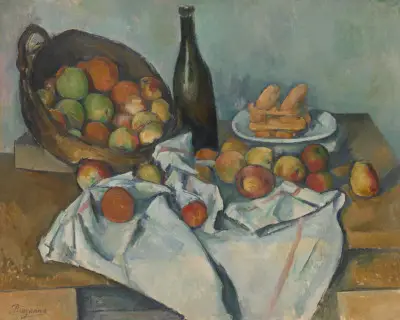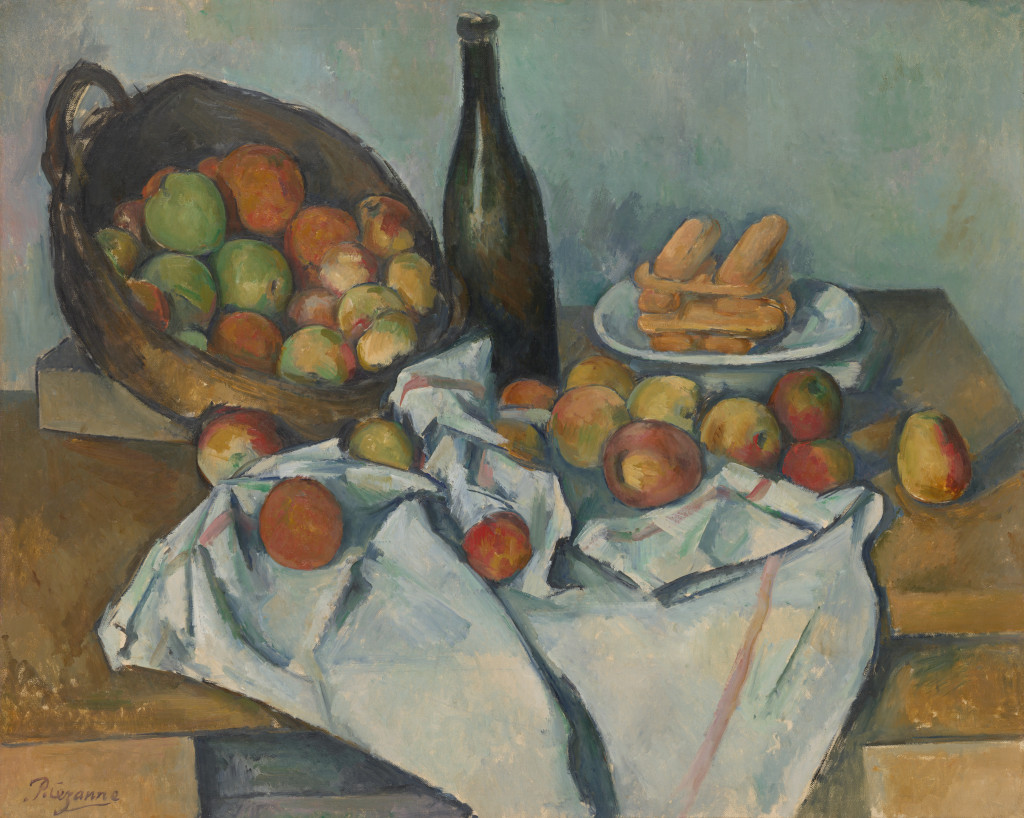The Basket of Apples is an important work by French painter Paul Cezanne that currently resides at the Art Institute of Chicago. Here we dissect the artwork itself and place it within the artist's overall career.
Paul Cezanne would go to extraordinary lengths to master his handling of still life art. He would paint and draw the same objects over and over again, never tiring of his desire to master this art form. Eventually he could work almost without thinking, capturing different arrangements within his studio whilst concentrating on the innovative aspects of his work. He would essentially revive this stale genre and his experimental use of perspective would bring about the Cubist art movement shortly after. Whilst we all understand the importance of still life work within his career, one does not always examine individual elements of this body of work, but we do so here with The Basket of Apples from circa 1893.
The studio in which he produced many of these masterpieces has since been examined itself in great detail as well to understand more about the precise manner in which he planned these well balanced compositions. The artist liked to use fruit within his paintings for reasons that went far beyond just their aesthetic value to each artwork. He lived in the countryside and understood their character, their smell, and also their background in how they came to arrive on his table. Cezanne therefore felt a strong connection to nature within his paintings by including some of these items and it also helped to represent his own life, whilst living in the more rural parts of France.
In order to allow the viewer to connect to these elements, the artist would even angle the table that defied normal rules of perspective. Cubism formed as a direct consequence of his work and used many of the same techniques in re-imaginging perspective within a still life setting. It was around the mid 1870s that Cezanne started to devote more of his time to this genre and initially wanted to bring more dimension into his paintings, but eventually would develop whole new ideas around the use of perspective that would inspire some major artists who followed on in the first half of the 20th century. Cezanne's method was to use incredibly subtle gradations of colour which produced eye catching recreations, rather than relying solely on dramatic lighting or shadows.
Table of Contents
- Description of the Painting
- What other Still Life Paintings did Paul Cezanne Produce?
- What is the Meaning behind The Basket of Apples?
- When was the Artwork Created?
- Where can The Basket of Apples be Found Today?
- Discussion of the Painting
Description of the Painting
Each and every element included in this painting was carefully arranged by the artist. The wine bottle at the top offers a vertical balance to the overall piece and sits centrally on the table. A table cloth hangs over the edge in front of us, with several items of fruit helping to keep it from falling off completely. A large basket leans over, allowing many of the oranges and apples to roll out onto the table. To complete the setting, a small ceramic plate with bread is positioned in the right hand corner. The artist chose to sign this piece which is relatively rare across his career, underlining the satisfaction that he felt once it was completed in circa 1893. The wall behind the table is deliberately plain in order to avoid distracting us and this tone continues into many of his landscape paintings from around the same period.
What other Still Life Paintings did Paul Cezanne Produce?
This was an artist who adored the still life genre. He repeatedly returned to it on many occasions, often re-using many of the same items across different compositions. Fruit was particularly common, as were other items that you might expect to find on a table, such as ceramics and glassware. Flowers could also add variation in colour which was another important consideration for Cezanne. His main method for alternating his work was to arrange each composition in a different manner, such as with a change in focus to just a section of a table, or to alter the arrangements of these items each time. Some of the best examples of his still life work, besides The Basket of Apples, includes Still Life with Apples, The Blue Vase and Apples and Oranges.
What is the Meaning behind The Basket of Apples?
Paul Cezanne wanted to create a new reality which ran parallel to nature, but was not restricted by the same rules. He would therefore plan his compositions with great care, which is something that an untrained eye would likely miss within artworks such as The Basket of Apples. Everything is carefully balanced across the table, with the table cloth over hanging in one direction whilst the basket pushes away in the opposite way. This amending of angles from what the artist would have seen at the time laid the groundwork for the Cubism movement to appear in later years. In previous centuries still life art was merely used as a means to display technical mastery, rather than to innovate as Cezanne would do in the late 19th century.
When was the Artwork Created?
The Basket of Apples was completed in 1893, at which point Paul Cezanne would have been approaching his mid-fifties. He would carry on for another decade yet, eventually passing away in the very early 20th century. This painting therefore represents an artist at the peak of his powers, working in the manner that he chooses rather than pandering to the needs of his patrons. Cezanne had also completed his artistic development by this point and was now entirely comfortable in the Post-Impressionist nature of his work which had been forged and fostered over a number of decades.
Where can The Basket of Apples be Found Today?
Head to the Art Institute of Chicago to see Paul Cezanne's The Basket of Apples in person. It was acquired by this institution in 1926 and is connected to the Helen Birch Bartlett Memorial Collection which brought a number of items into their permanent display. Within the 1920s this painting changed hands several times between different collectors but eventually made its way over to Chicago in the United States. The painting today, were it ever to come up for sale, could quite possibly achieve a price tag of over $100m, though it is highly unlikely that its present owners would ever be willing to put it up for auction.
Discussion of the Painting
With The Basket Of Apples, Paul Cezanne revived the unfashionable genre of Still Life and breathed new life into the field. The 1893 work was an oil painting, but it subverted the genre basically by trying to be less slavishly accurate than previous artists. On the face of it, it is a humdrum piece featuring a basket, apples, biscuits and a table. But it is inaccurate and that inaccuracy leads to its genius. Cezanne did not see art as an imitation of life, presumably his inaccuracies led to something better. He recognized that artists were not bound by a requirement to reproduce life. The Basket of Apples contains tilted tables and an impossible rectangle with no right angles.
There is a sensation that the painting is rolling away to the left. It is strange, disorientating and addictive. Still Life was an old fashioned genre and Cezanne appears to have found an opportunity to revitalise the form by finding ways to be playful and challenge received wisdom within the art world. This particular work became very influential. Matisse also found fresh ground to plough through still life and subverting the form. Photography & cinema made painting a facsimile of reality a redundant form. A camera could do that. Artists needed to interpret something more. Cezanne started that. Arguably, Jackson Pollock and other contemporaries took it to its logical conclusion.
It might look at first that the artist is ‘bad’. A schoolchild would be told the error of their ways. But Cezanne is deliberate with this oddness. The table has the sensation of rolling away, the bottle looks drunker than anybody drinking the liquor and the biscuits are baffling but look like an early game of Jenga to my eye. Any amateur painter will tackle either the still life or the landscape at some point. Artists like Turner had broken the rules of the landscape a century earlier. Just before the dawn of the 20th century Cezanne challenged your ways of seeing the world around you even more.





